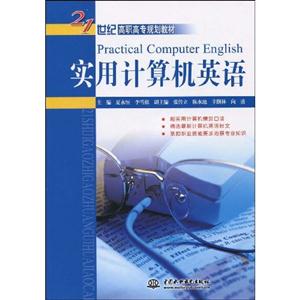-
>
西班牙语词根宝典
-
>
英语大书虫世界经典名译典藏书系:中国人的精神 (英汉对照)(精选权威版本)
-
>
许渊冲译唐诗三百首:汉文·英语
-
>
四级词汇词根+联想记忆法:乱序版
-
>
The secret garden
-
>
英国文学名篇选注
-
>
许渊冲译千家诗
实用计算机英语 版权信息
- ISBN:9787508467399
- 条形码:9787508467399 ; 978-7-5084-6739-9
- 装帧:一般胶版纸
- 册数:暂无
- 重量:暂无
- 所属分类:>>
实用计算机英语 本书特色
《实用计算机英语》:超实用计算机情景口语、精选*新计算机英语时文、紧扣职业技能要求拓展专业知识。
实用计算机英语 内容简介
《实用计算机英语》大部分内容都和日常使用的计算机密切相关,实用性强。书中内容有的是从一些计算机设备说明书中摘录的,有的是从软件使用手册或帮助中精选的,甚至有些内容是从软件的界面上选取的。通过学习《实用计算机英语》可以在将来更好地理解计算机相关设备的使用和软件的操作等。此外,《实用计算机英语》还增加了对话内容,让读者在学习计算机英语知识的同时,还可以了解在面试求职、产品讨论等方面计算机类英语口语的表达。每节设有“Warm-up”部分,通过提出问题让读者在阅读《实用计算机英语》时有一定的目的性,并给本节内容做一个铺垫。 《实用计算机英语》主要适合高职高专类计算机相关专业的学生使用,同时也可作为本科类专业的辅助教材,还可以作为计算机类相关职业培训的教材。
实用计算机英语 目录
实用计算机英语 节选
《实用计算机英语》大部分内容都和日常使用的计算机密切相关,实用性强。书中内容有的是从一些计算机设备说明书中摘录的,有的是从软件使用手册或帮助中精选的,甚至有些内容是从软件的界面上选取的。通过学习《实用计算机英语》可以在将来更好地理解计算机相关设备的使用和软件的操作等。此外,《实用计算机英语》还增加了对话内容,让读者在学习计算机英语知识的同时,还可以了解在面试求职、产品讨论等方面计算机类英语口语的表达。每节设有“Warm-up”部分,通过提出问题让读者在阅读《实用计算机英语》时有一定的目的性,并给本节内容做一个铺垫。《实用计算机英语》主要适合高职高专类计算机相关专业的学生使用,同时也可作为本科类专业的辅助教材,还可以作为计算机类相关职业培训的教材。
实用计算机英语 相关资料
插图:Multi-Core ProcessingIn 1965, when he first set out what we now call Moore's Law, Gordon Moore (who laterco-founded Intel Corp.) said the number of components that could be packed onto an integratedcircuit would double every year or so (later amended to 18 months). In 1971, Intel's 4004 CPU had 2,300 transistors. In 1982, the 80286 debuted with 134,000transistors. Now, run-of-the-mill CPUs count upward of 200 million transistors, and Intel isscheduled to release a processor with 1.7 billion transistors for later this year.For years, such progress in CPUs was clearly predictable: successive generations of semiconductortechnology gave us bigger, more powerful processors on ever-thinner silicon substrates operating atincreasing clock speeds. These smaller, faster transistors use less electricity, too.But there's a catch. It turns out that as operating voltages get lower, a significant amount ofelectricity simply leaks away and ends up generating excessive heat, requiring much more attentionto processor cooling and limiting the potential speed advance——think of this as a thermal barrier. To break through that barrier, processor makers are adopting a new strategy, packing two or morecomplete, independent processor cores, or CPUs, onto a single chip. This multi-core processor plugsdirectly into a single socket on the motherboard, and the operating system sees each of the executioncores as a discrete logical processor that is independently controllable. Having two separate CPUsallows each one to run somewhat slower, and thus cooler, and still improve overall throughput forthe machine in most cases. From one perspective, this is merely an extension of the design thinking that has for several yearsgiven us n-way servers using two or more standard CPUs; we're simply making the packagingsmaller and the integration more complete. In practice, however, this multi-core strategy represents amaj
- >
烟与镜
烟与镜
¥17.3¥48.0 - >
朝闻道
朝闻道
¥15.0¥23.8 - >
龙榆生:词曲概论/大家小书
龙榆生:词曲概论/大家小书
¥9.2¥24.0 - >
自卑与超越
自卑与超越
¥16.7¥39.8 - >
新文学天穹两巨星--鲁迅与胡适/红烛学术丛书(红烛学术丛书)
新文学天穹两巨星--鲁迅与胡适/红烛学术丛书(红烛学术丛书)
¥9.9¥23.0 - >
唐代进士录
唐代进士录
¥18.3¥39.8 - >
伯纳黛特,你要去哪(2021新版)
伯纳黛特,你要去哪(2021新版)
¥16.9¥49.8 - >
大红狗在马戏团-大红狗克里弗-助人
大红狗在马戏团-大红狗克里弗-助人
¥3.6¥10.0
-
4.23文创礼盒A款--“作家言我精神状态”
¥42.3¥206 -
4.23文创礼盒B款--“作家言我精神状态”
¥42.3¥206 -
一句顶一万句 (印签版)
¥40.4¥68 -
百年书评史散论
¥14.9¥38 -
1980年代:小说六记
¥52.8¥69 -
中图网经典初版本封面-“老人与海”冰箱贴
¥20¥40




















